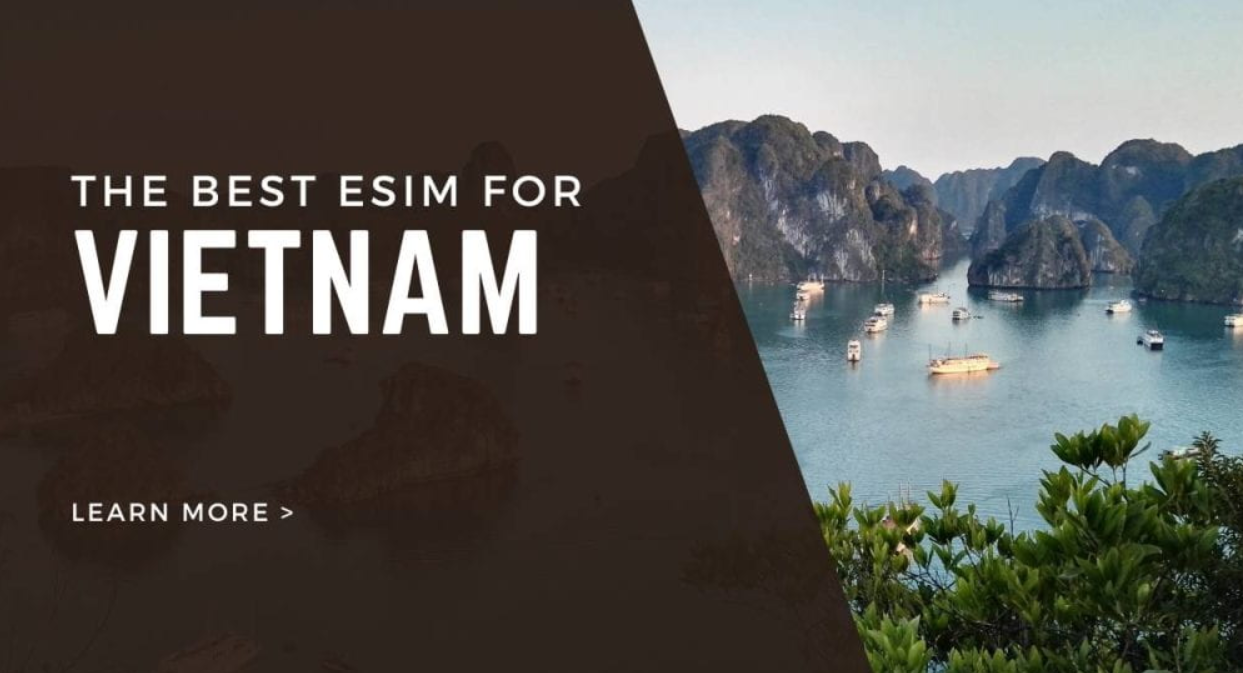Best eSIMs for Vietnam: If you’re a regular reader of this blog, you know I’m passionate about reducing stress and simplifying logistics so you can focus on enjoying local experiences and fully immersing yourself in the culture while traveling.
Confidently navigating city streets, easily ordering a taxi, or staying connected with locals is crucial to my travel philosophy.
As someone who frequently visits Vietnam and has lived in Hanoi, I understand the necessity of reliable internet access in the country. Vietnam is quite advanced in this area, offering 5G services nationwide.
So, the key question is: What’s the best way for travelers to stay online?
Previously, buying a plastic SIM card from a shop like the one above was the only choice. With the advent of eSIM technology, travelers now have a convenient alternative that saves time, money, and stress.
In this guide, I’ll review the 6 best eSIM options for Vietnam and guide you through the entire process of purchasing and using an eSIM during your next trip to Vietnam.
Do You Even Need a SIM Card for Vietnam?
WIFI is widely available in Vietnam, found in hotels, restaurants, and cafes in major cities like Hanoi, Danang, and Saigon. However, as you venture further out, access becomes less reliable, and speeds can be slow. Some homestays don’t offer WIFI, and steady connections can be scarce in remote national parks and rural areas.
Even in the cities, having your own SIM card is highly beneficial. During my time in Hanoi and traveling around Vietnam, I used my phone daily for ordering taxis, motodops (motorbike taxis), and navigating with Google Maps.
Internet access is essential for purchasing bus and train tickets, using Google Translate, and staying in touch with guides and hosts through instant messaging services.
Tip: Zalo is the most popular instant messaging service in Vietnam, with around 80% of smartphone users having it installed.
If you want to stay connected to Instagram, Facebook, watch YouTube vlogs, or access Vietnam travel blogs like this one, having data is a worthwhile investment!
What is an eSIM?
An eSIM is an embedded technology built into your mobile phone or iPad. It functions similarly to a regular SIM card but is entirely digital.
While a traditional SIM card uses a physical card, an eSIM is remotely programmable. This means you can change carriers and acquire data packages using only software. Typically, an eSIM is activated by scanning a QR code and managed through an app.
eSIM technology has been around since 2017, but it continues to evolve. If you purchased your phone (or iPad) in the last five years, it’s likely eSIM-compatible. Check out the full list of compatible models.
eSIM vs. Traditional SIM: Quick Comparison
Here are some advantages of using an eSIM:
- Save Time: No need to visit a shop to buy a physical SIM card. You can set everything up before your trip, so you’re ready to go as soon as you arrive. There’s no need to swap plastic cards, minimizing the risk of losing or damaging your home SIM.
- Easy Activation: You can purchase and activate an eSIM online before you travel. There’s no need for a contract or personal information, and activation is usually instant, unlike traditional SIMs that require SMS validation and APN configuration.
- Cost Savings: If you use international roaming, an eSIM can save you a significant amount of money. For example, roaming charges on some networks are much higher than eSIM rates.
- High-Speed Internet: eSIMs are compatible with 4G/LTE/5G networks, offering faster speeds than the 2G or 3G networks typically available with roaming packages or public WIFI.
- Increased Privacy & Security: Avoid using unsecured public WIFI networks with an eSIM. Paired with a VPN (like ExpressVPN), you can browse and use internet banking services securely. eSIMs receive automatic security updates.
- Keep Your Home SIM Active: With an eSIM, you don’t need to remove your home SIM card. You can keep your mobile number active for receiving SMS, 2FA codes, and phone calls (though additional charges may apply). The eSIM is particularly useful if your phone has only one SIM card slot.
- 24/7 English Support: Many eSIM providers, like Airalo and SimOptions, offer online support in English, so you can get help whenever needed.
The 6 Best eSIMs for Vietnam
Here’s a roundup of the top eSIM plans available for Vietnam:
- Asia Link Regional eSIM (10 GB)
Price: From $37
Data: 10 GB
Valid for: 30 days
Network: Viettel & Mobifone
Perks: Top-ups available, longest validity period, reputable provider Asia Link is my top choice for eSIM data in Vietnam. Offered by Airalo, a leading eSIM provider, it provides 30 days of data and allows for reloading. It connects to the reliable Viettel network and has a user-friendly app. - eSIM2FLY Global
Price: From $49.90
Data: 6 GB
Valid for: 15 days
Network: Viettel & Vietnamobile
Perks: Top-ups enabled, local phone number, calling & texting The eSIM2FLY Global by AIS is a global eSIM with 5G support for Vietnam. It includes a Thai phone number and allows for making and receiving calls, with various top-up options available. - TripRoaming eSIM for Vietnam
Price: From $4.71
Data: 1-30 GB
Valid for: 3-30 days
Network: Viettel
Perks: Flexible packages, hotspot enabled TripRoaming offers flexible data packages and is hotspot-enabled, useful for tethering other devices. It works in Vietnam and seven other countries. - Smart Traveller eSIM
Price: From $17.90
Data: 6 GB
Valid for: 10 days
Network: Viettel
Perks: Affordable, regional coverage Ideal for short trips, this eSIM activates immediately and has a one-year validity period. It covers 27 countries and does not include calls or SMS. - Discover Global eSIM (10 GB)
Price: From $59
Data: 10 GB
Valid for: 60 days
Network: Vietnamobile
Perks: Global coverage, top-ups available Offered by Airalo, this eSIM covers 87 countries and has a validity period of up to 180 days. It allows for top-ups and is suitable for long-term travelers. - Drimsim Pay-As-You-Go eSIM
Price: €0.03/MB (+ €10 for the eSIM)
Data: No limit
Valid for: One year
Perks: Pay for what you use, global coverage, hotspot enabled Drimsim offers a pay-as-you-go model, charging only for the data used. It works in 190 countries and is hotspot-enabled, providing global coverage without monthly fees.
How to Activate an eSIM
Activating an eSIM is simple. You’ll need an internet connection, so it’s best to do this before you travel or when you arrive at your first hotel. After purchasing your plan, you’ll receive an email with a QR code. Scan the code with your mobile phone to open the app and follow the instructions to connect to the carrier.
Tip: If you have only one device, ask someone to take a photo of the QR code so you can scan it later.
Activate the eSIM only when you’re ready to use it. Most providers start the validity period as soon as the eSIM is installed.
If you have multiple phones, ensure the eSIM is installed on the correct device, as transferring it is difficult and the service cannot be shared.
Upon arrival in Vietnam, make sure your phone is connected to the appropriate network (Viettel, depending on your provider).
How Much Data Do You Need for Vietnam?
Most eSIM plans offer 6 GB of data. Here’s a general idea of what you can do with 6 GB:
- General Internet Browsing: 75-100 hours (approx. 3,500 web pages)
- Google Maps: 15,000 locations
- Instant Messaging/Emails: 2 million (no attachments)
- YouTube Streaming: 5-10 hours (SD)
- Netflix Watching: 6 hours (SD)
Quick Tips for eSIM Use
- Deactivate/Remove eSIM: If you’re using multiple eSIMs, deactivate or remove the one you don’t need to avoid accidental usage.
- Use a VPN: Protect your data while traveling by using a VPN service like ExpressVPN.
- Check Compatibility: Ensure your phone is unlocked and compatible with the eSIM technology.
Conclusion
An eSIM offers significant advantages over traditional SIM cards, providing ease of use, cost savings, and better connectivity. With multiple options available, you can find an eSIM plan that fits your needs and enjoy your travels in Vietnam with seamless internet access.



